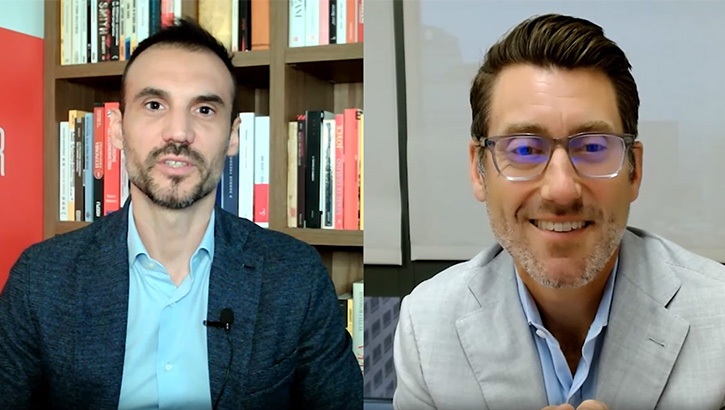
Bond yields are suddenly big news again, and in the UK they are a reflection of a deepening political crisis. Yields are on the march across the world, but because bonds are generally less well understood by investors than stocks, many people don’t know whether this is a good or bad thing.
On the surface, rising yields sound positive in that holders of bonds get paid more. But in an era of soaring inflation and economic turbulence, nothing is quite what it seems.
A stock’s yield is a function of the price and moves in opposite directions – a falling share price will push the yield higher and vice versa. And it’s the same with bonds, where yields and prices move around hourly and daily.
The "fixed" part of "fixed income" refers to the coupon and not the yield – if I buy a government bond with a five-year maturity, I will get the same amount of money back as income over that period, but the price and the yield of that bond will fluctuate over those five years. I will, of course, receive my original investment back if I hold for five years. And that’s a big appeal for bond investors over shares, where capital security is by no means guaranteed. I wrote about this in detail in my explainer What is a Bond?.
Should I Buy Bonds Now?
There’s a big "if" implied in buying bonds, though. Issuers, whether governments (local/national) or companies, need to stay in business or not default on their debt to keep paying investors income. There’s a world of difference between buying a bond issued by the Switzerland government, which has the highest "AAA" credit rating from S&P, and, say, a new technology company trying to raise money. Here you would assume the Swiss bond yields less than the tech stock because of the risk of default.
Whichever entity sells you the bond wants to keep paying you back, but may not be able to because it runs into financial trouble. This is less likely for sovereign governments, especially ones that control their own currencies, but it does happen, especially in emerging markets.
At time of writing, Switzerland’s 10-year bond yields 1.29% but Brazil’s yields 12%. The market’s not saying that Brazil is about to default on its debt, but that this is more likely than Switzerland doing so (the yield difference also takes into account interest rates and inflation, of which more later).
The Eurozone debt crisis may be a distant memory for many investors but it provided a textbook case of high yields flagging up risk. Greek debt yielded nearly 30% at one point – and the country did default on its debt, going to the International Monetary Fund for a bailout. (Greece’s 10-year bond currently yields around 4.75%, just above the UK’s 10-year gilt). Investors at that yield will either have been very brave or very foolish.
As well as compensating investors for the higher risks, high yields can flag up a big case of buyer beware. That’s definitely the case in the corporate bond market, where companies with worse credit ratings (issuing “junk bonds”) need to offer higher yields to tempt investors to take on the higher risk. In good economic conditions, defaults are generally low, and markets can overprice risk, to the benefit of yield hunters.
To loop back to my introduction, yields go up because investors sell bonds, pushing down their prices. That can highlight a loss of confidence in the issuer’s economic or corporate strategy – for example, investors reacted strongly against a UK budget offering higher spending and tax cuts, a sort of financial vote of no confidence in the country’s outlook.
The UK had previously been seen as a safe bet for bond investors but recent events suggest that perception has changed. So yields can act as a ready reckoner for investors to see how risky markets perceive a bond to be.
Hiking Cycle
As well as risk, government bond yields also tell us about inflation and interest rate expectations. We’re now living in a high-inflation era and interest rates have been rising sharply, particularly in the US, where the Federal Reserve has been hiking aggressively. US interest rates are expected to break through 4% by the end of 2022 – and a one-year Treasury bond yields just over 4%.
In economic history, periods of rising inflation are expected to be bad for bonds: new issues of debt have to offer higher yields to compete with other "risk-free" assets like cash. And rising interest rates mean bond yields can look uncompetitive very quickly.
Where does this leave investors, savers and mortgage holders? Clearly we’ve moved away from the unusual era when investors were effectively paying governments to own their bonds – German and Japanese debt offered negative interest rates at one point. That period was not a great one to be a new bond buyer. Prices were elevated and yields were low. But what needs to be considered is why bonds are owned in the first place.
Because of their predictable cash flows and lower risk profile – especially for the likes of Switzerland – they are meant to offer some element of safety in volatile times.
In the March 2020 Covid-19 crash, these bonds were in high demand as "safe havens". Investors were willing to overlook the tiny or negative yield just to own a more secure asset. In that case yields were a very secondary consideration to the investment proposition – investors bought bonds despite the yields rather than because of them.
Low Volatility Asset Shows High Volatility
Retail investors are not usually big buyers of government bonds, but you may have exposure to the asset class in your portfolio. Bonds have recently exhibited high volatility across the world, which is unusual for an asset class that is supposed to offer more stability than equities.
"It’s been the most volatile bond market going back to the 90’s," says Morningstar senior manager research analyst Peter Marchese. That is a reflection of the uncertain environment of 2022 in the wake of the Ukraine war, inflation spiral, energy crisis and rotation to value.
Rising corporate bond yields also offer mixed signals: an investor may be tempted by the better yields, but the next corporate debt issue may offer an even higher yield. And let’s get back to the original purpose of bonds – to raise money for the company or government. If they have to pay out more in bond income, as well as absorbing rising material and labour costs, and that means something will have to give, whether that’s dividends or buybacks.










:quality(80)/cloudfront-us-east-1.images.arcpublishing.com/morningstar/Q7DQFQYMEZD7HIR6KC5R42XEDI.png)

















